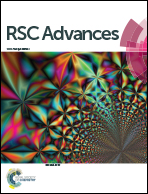Silver incorporated antibacterial, cell compatible and bioactive titania layer on Ti metal for biomedical applications
Abstract
Surface modification of titanium and titanium alloys is an attractive method to improve the biological affinity of orthopaedic and dental devices. Although osteointegration is enhanced by surface modifications, bacterial related infections sometimes lead to implant failure and secondary surgery. In the present study, attempts were made to incorporate the antimicrobial agent silver into titanium metal pre-treated with H2O2. Fine nano network structures of hydrated titania uniformly formed by the H2O2 treatment were decorated with silver particles of 5–10 nm by subsequent AgNO3, and, these silver particles remained stable over the titania network even after heat treatment. An antibacterial study of titanium metal subjected to H2O2–AgNO3 showed a zone of inhibition in Staphylococcus aureus compared to an H2O2 pre-treated and untreated control specimen. Steady release of silver from the thus treated titanium metals into simulated body fluid indicates that these silver particles are released as silver ions and are responsible for the antibacterial activity. About 99.7% bacterial killing efficiency was observed for a 6–8 ppm (1 mM AgNO3) silver containing Ti surface and is optimised as the highest tolerable silver limit. The cytotoxicity assay and cell adhesion study on MG63 osteosarcoma cell lines confirmed the present silver concentration does not show any toxicity. Further, bone like apatite formation of chemically and heat-treated titanium in simulated body fluid indicates this surface modification method could be suitable in various medical devices.


 Please wait while we load your content...
Please wait while we load your content...